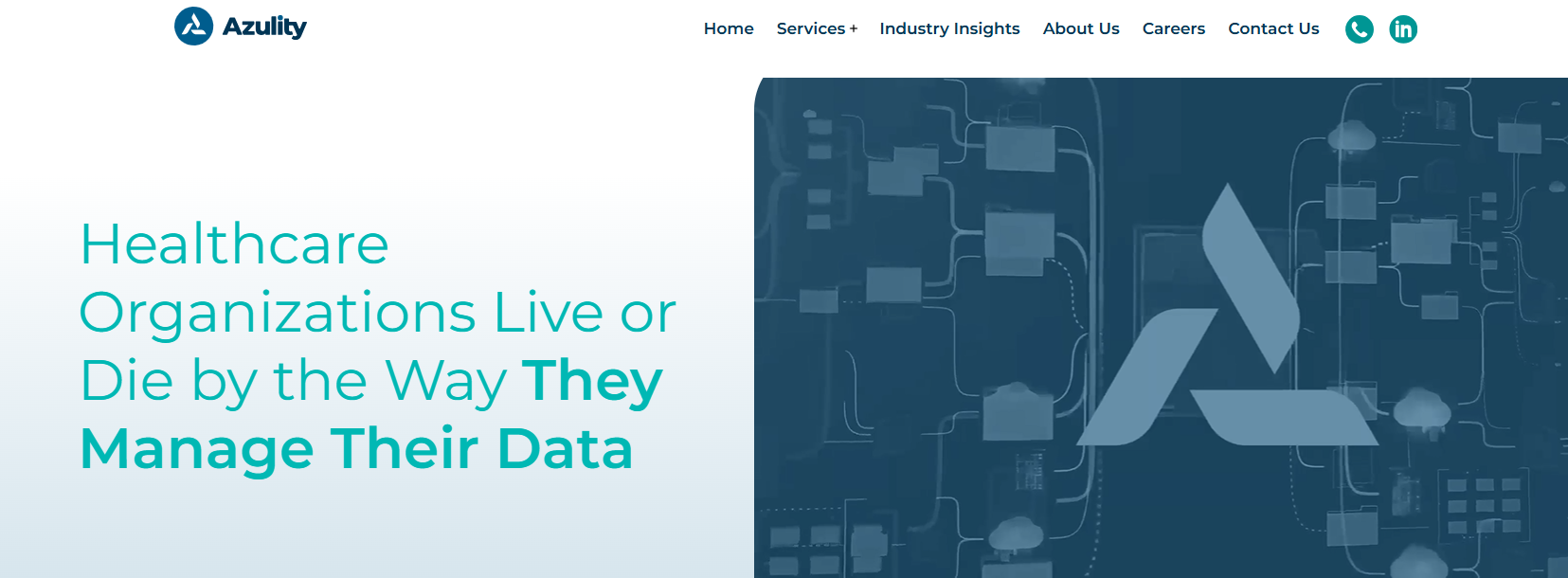Hiring programmers to move your startup forward can feel overwhelming, especially if you don’t have a technical background. Think about it: you’re trying to build a team to help develop your product, but you don’t even know what skills you’re looking for. You’re not alone if this makes you feel anxious. Learning how to hire data scientists can also be a crucial part of this process, as their expertise might be essential for your startup’s success.
But as a startup founder, you must push through the discomfort and build a talented team of developers to help you achieve your goals. This guide will help you tackle the technical challenges of hiring programmers for a startup to help you allow healthcare organizations through innovative data management.
One way to reduce some of the strain of this process is to utilize Azulity’s provider credentialing services. Our solution can help you achieve your objectives by tackling the vital tasks of verifying and managing healthcare data so your new team can focus on their core responsibilities.
Responsibilities of Programmers


Programmers, coders, or software developers are vital team members who build, test, and maintain software applications. While every organization has unique technologies and needs, programmers generally specialize in particular coding languages.
For example, a Python developer concentrates on writing code in Python and may use other languages as needed to complete a project. Python is commonly used for artificial intelligence and machine learning applications, so this programmer might work to develop software for a machine learning project.
Like many technical positions, the specific duties of programmers vary based on their employer, team, and projects. However, most programmers share several responsibilities, including:
1. Collaborating with the Company to Understand Its Vision
This is the cornerstone of the job of a computer programmer. Whether they are the sole engineer at a startup or a member of an extensive product department at a Fortune 500 company, they must first map the product development schedule and maintenance requirements.
In addition to developing code, team members from various departments may participate in “whiteboarding” or collaborative problem-solving to identify the strategy for resolving business challenges. Competent programmers take the time to ensure that they comprehend the requirements, push back when required, and transform business needs into technical requirements so that projections can be made before commencing work.
2. Writing Code for Software and Computing Systems
Along with software and web developers, computer programmers create code for innovative mobile apps and computer programs. In some instances, programmers collaborate closely with user experience (UX) designers to write code that complements a new software application’s appearance, touch, and performance.
Programmers use various languages, including JavaScript and Ruby, to create software applications. They also employ repositories of basic code that can be updated or altered for a given application to accelerate this process. Sometimes, they may need to adapt their code to different system platforms, such as Web, mobile, Windows, or Mac OS X.
Building new code often entails much experimentation and error. Consequently, computer programmers possess exceptional critical thinking and problem-solving abilities and prefer utilizing logic to tackle complex issues.
3. Writing and Installing Updates for Existing Systems
Computer programmers generate and execute software program upgrades. A software update may offer a bug fix or new functionalities to enhance the user experience. These projects may take just days to several months, based on the intricacy of the upgrade. The end-user may be an employee within the organization or an external product buyer.
4. Ensuring Consistent Performance
Programmers spend most of their time testing, maintaining, and debugging software. It is crucial to create the program and ensure that it functions properly. Programmers must often test their code, mainly if they’re working with other team members, to ensure it doesn’t conflict with anyone else’s.
This may include dozens, hundreds, or thousands of functional and unit tests before the program enters the quality assurance phase (QA). Programmers write unit tests to confirm that small portions of code (units) function as envisioned. Conversely, they may assist with debugging specific malfunctioning components of a site or computer program.
Notably, younger programmers spend significant time upgrading existing programs and conducting tests to identify defects and ensure software functionality.
5. Helping in New Feature Development
Generally, software engineers and developers are responsible for designing application upgrades, while programmers are responsible for configuring these modifications into the computer’s system. For instance, they may add a scheduling function to task management software or incorporate a Facebook application programming interface (API) into a website so customers can log in with their Facebook profiles.
6. Adapting Programs for Different Environments
Rewriting programs for various operating systems is another component of a programmer’s responsibilities. They must often rewrite code in several languages to make an application compatible with multiple operating systems and platforms. Windows and OS X apps, for example, are coded differently. Some programmers are taught to convert legacy programs into code for software as a service (SaaS) compatible with both operating systems.
7. Operating in a Team-Driven Workplace
Several IT departments use agile software development frameworks like Scrum and Kanban to manage workflow. The Scrum framework involves splitting work into tasks that programmers may finish in 2-4 week-long cycles, or “sprints.” Development teams, including computer programming and other disciplines, must collaborate to create the final product.
A component of the Scrum framework is regular stand-up meetings and consistent team engagement. Most programmers are at work for full 40-hour weeks to meet deadlines and resolve technical challenges while attending frequent meetings.
Using a common framework, such as a platform engineering system, might well be a component of a computer programmer’s job responsibilities in organizations heavily focused on teamwork.
8. Factoring in Security
Programmers must safeguard programs from cyber threats by guaranteeing minimal vulnerabilities and incorporating security mechanisms. Several programmers might even work in cybersecurity, assisting in identifying malicious software and repairing systems that may be susceptible to hacking. In addition, programmers may develop expertise in composing code that eliminates security flaws and data leaks.
What to Consider When Hiring A Programmer for A Startup


1. Embracing Setbacks: Look for Candidates Who Can Bounce Back From Failure
Startups operate in environments rife with uncertainty and unexpected challenges. As a result, failure is often part of the journey. Innovative startups understand that setbacks can be valuable learning opportunities. As you look to bring a programmer onto your team, find someone who can embrace the failure that’s often part of the innovation process. The right candidate will accept mistakes — both their own and those of others — and focus on what can be learned to foster continuous improvement moving forward.
2. Team Players Are A Must
Startups often invest heavily in the latest technologies to help build their businesses. While this can be an effective strategy, it’s critical to understand that tools are only as good as those who use them. Even the most advanced technologies can fall flat without a solid collaborative strategy. Innovation and effective operations depend on teamwork. The collective strengths of team members push projects forward, improve ideas, increase efficiency, and reduce stress. When hiring a programmer for your startup, look for someone who values collaboration and has a history of working well in teams.
3. Hire for Proactivity and Confidence
One of the most significant differences between established companies and startups is that startups often move faster and take more risks. To stay competitive, they need teams that can constantly innovate, identify opportunities, analyze them, and execute to make the business more attractive to its target audience. As such, you need a workforce that can leverage opportunities as they arise — even daily or weekly. When hiring programmers for your team, look for candidates who demonstrate proactivity and the confidence to move forward with their ideas.
4. Can They Thrive in an Unstructured Environment?
Established companies often have tested structures and processes that are integral to operations. Startups, on the other hand, mostly thrive in significantly less structured environments. What works for a team of five people working on two projects cannot work for 20-30 people working together on 40+ projects. It’s crucial to assess if candidates can thrive in this fluid environment. It’s better not to hire professionals who prefer the stability of predictable and fixed structures like annual performance reviews and budget approval systems.
5. Look for Intrapreneurs
Futuristic ideas shaped by modern and original thinking have gained popularity in computer science. And the most common epicenter of these innovations is startups. The rising term to coin this phenomenon is intrapreneurship. As the name suggests, it refers to someone in a company who holds the potential to propose innovative new ideas by looking through previously unknown territories and putting in the effort to get those ideas to life.
Understand that as a startup, it is vital for you to allow those intrapreneurs time to be creative and recognize their accomplishments. Therefore, by implementing professional development practices, you should hire someone who can take chances and suggest brilliant additions to your business landscape. You can evaluate the developers by asking them the right questions. For example – What measures will you take to improve the company?
6. What’s Their Level of Initiative?
When you have a business to run, you cannot micromanage and supervise every little task your employees are working on. Instead, you can lay out your business goals and objectives at the beginning and allow them to develop new and unique ideas to move the business closer to those goals. You can evaluate the applicants by asking questions such as:
- Given the option, what would you like to add to our company’s mission statement?
- What would be your first step towards achieving the company’s goals and objectives?
That’s why whenever you hire software engineers for your startup, ensure they can work in a fluid environment while taking the initiative, working without a project manager’s supervision, handling senior software engineers’ roles, and commencing projects independently.
7. Technical Skills Are Still Critical
While hiring for soft skills is essential, don’t forget that technical knowledge is necessary to assess and choose the right technologies and programming languages to build, manage, and validate products. A capable software engineer with the same interest as hiring managers can invest significantly in the startup’s growth and business vision. They can efficiently handle development processes, decide on the right technology, and even address the complete set-up of IT infrastructure for product development.
That’s why you must ensure that the applicant has adequate technical knowledge and experience in building, launching, monitoring, and scaling software solutions. Also, evaluating candidates’ soft skills is essential as remote teams require collaboration, efficient communication, and time management skills.
Azulity specializes in healthcare master data management and provider credentialing services, bringing proven expertise in implementing healthcare data solutions and credentialing across the US. Our comprehensive platform ensures consistent patient, provider, location, and claims data synchronization across all systems and departments.
Key features include healthcare MDM, provider MDM, reference data management, credentialing, and provider enrollment. We serve healthcare technology leaders – from CIOs and CDOs to VPs of data platforms and credentialing – helping them eliminate the costly problems of fragmented data systems. Book a call to learn more about our healthcare master data management services today!
Related Reading
- Scrum Master Roles and Responsibilities
- What to Look for When Hiring a Project Manager
- Solution Architect Roles and Responsibilities
- How to Hire a Project Manager
- Project Executive vs Project Manager
- Mistakes to Avoid When Hiring Developers
- What to Ask When Hiring a Data Scientist
How to Hire Programmers for a Startup in 6 Steps


1. Use Azulity for Data Management Hiring Needs
Azulity specializes in healthcare master data management and provider credentialing services, bringing proven expertise in implementing healthcare data solutions and credentialing across the US. Our comprehensive platform ensures consistent patient, provider, location, and claims data synchronization across all systems and departments.
Key features include healthcare MDM, provider MDM, reference data management, credentialing, and provider enrollment. We serve healthcare technology leaders – from CIOs and CDOs to VPs of data platforms and credentialing – helping them eliminate the costly problems of fragmented data systems. Book a call to learn more about our healthcare master data management services today!
2. Networking Opportunities
Get out there and start meeting people at various tech conferences and meetups. Socializing with a tech community that might have connections or referrals will increase the likelihood of hiring developers for startups. You never know what kind of leads this may uncover. If you don’t mind hiring suitable candidates with lower experience levels but still great potential, look for bootcamp graduates or recent college grads eager to learn and grow in their roles.
3. Use Social Media to Find Programmers
Look outside traditional job boards because some of the best developers aren’t necessarily looking through these channels. To hire developers for startups, consider using social media platforms such as Twitter, LinkedIn, Facebook, and other online forums related to programming and technologies to widen your search pool significantly.
4. Highlight Your Competitive Advantages
Don’t forget that candidates evaluate you, too. As such, identify the strengths of your startup, whether it is an incredible corporate culture or a solid benefits package, and articulate them at the interview. This will make a big difference when convincing potential candidates why joining your company should become their priority choice above anyone else.
5. Prioritize Soft Skills
Apart from a vast technical background, pay attention to the developer’s soft skills, such as communication, problem-solving, and creativity. These traits often make a difference when you hire developers for startups, as you’ll quickly identify the one who stands out from their peers and ensure that a programmer will fit in effortlessly.
6. Follow Up Quickly
In today’s fast-paced world, response speed is key when hiring talented developers. Ensure you or your recruiter gives prompt feedback after the initial contact to avoid missing a valuable specialist.
Related Reading
- Questions to Ask When Hiring a Programmer
- Hiring Dedicated Developers vs In-House Developers: What Is Better?
- Scrum Master vs Project Manager
- How to Hire a Software Developer
- Data Architect Vs Data Engineer
- Quality Analyst Interview Questions
- Data Architect Roles and Responsibilities
- Data Analyst Skills Needed
- Skills Required for Project Manager
- Quality Analyst Skills
- Data Architect Skills
Where to Find Programmers for a Startup


1. Azulity


Azulity focuses on healthcare master data management and provider credentialing services. The company implements healthcare data solutions and credentialing across the US. Azulity’s platform helps healthcare organizations eliminate the costly problems of fragmented data systems. Key features include healthcare MDM, provider MDM, reference data management, credentialing, and provider enrollment. The company serves healthcare technology leaders, from CIOs and CDOs to VPs of data platforms and credentialing.
2. Job Boards and Career Websites
Job boards and career websites attract various candidates across experience levels.
Here are some worth mentioning
- LinkedIn: Post job listings and actively search for candidates using LinkedIn Recruiter tools.
- Indeed: Popular for reaching a wide range of candidates across experience levels.
- Glassdoor: Attract candidates interested in your company’s culture and reputation.
- AngelList: Ideal for finding programmers interested in startups.
3. Developer-Specific Platforms
Developer-specific platforms target experienced programmers with openings relevant to their skills.
Here are some of the best options to find qualified candidates
- Stack Overflow Jobs: Post openings to target experienced developers who are active in the community.
- GitHub Jobs: Access developers showcasing their coding projects and repositories.
- RemoteOK: Focused on finding remote programmers worldwide.
- We Work Remotely: Great for hiring remote tech talent.
4. Freelance and Contract Platforms
Freelance and contract platforms allow you to hire programmers for short-term, project-based, or contract work.
Here are some of the most popular options
- Upwork: Find freelance programmers for short-term or project-based work.
- Toptal: Access top-tier programmers vetted for quality.
- Fiverr: Hire programmers for smaller or well-defined tasks.
- Freelancer: A broad marketplace for finding programming talent.
5. Coding Bootcamps and Universities
Coding boot camps and universities can help you find qualified candidates with the right skills and knowledge for your needs.
Consider the following strategies.
- Partner with coding bootcamps to recruit recent graduates with hands-on experience (e.g., General Assembly, Le Wagon).
- Collaborate with universities and colleges offering computer science programs for fresh talent.
- Participate in university job fairs and tech events.
6. Developer Communities and Forums
Developer communities and forums provide access to active programmers who share their work, knowledge, and projects.
Here are some of the best options
- GitHub: Engage with developers who contribute to open-source projects.
- Reddit: Subreddits like r/forhire, r/cscareerquestions, and r/webdev can connect you with programmers.
- Dev.to: Developers share their work and knowledge here, offering networking opportunities.
7. Tech Conferences and Meetups
Tech conferences and meetups are great for networking with talented developers.
Consider the following options.
- Attend industry conferences like Google I/O, Microsoft Build, or smaller local tech meetups.
- Join programming meetups through platforms like Meetup.com or Eventbrite.
8. Social Media Platforms
Social media platforms can help you reach a broad audience of potential candidates.
Use these strategies to find programmers on social media
- Twitter: Many developers share their work and thoughts; search relevant hashtags like #programming or #developerjobs.
- Facebook Groups: Tech and programming-specific groups often have job posting sections.
- Discord: Join coding-related servers to find active programmers.
9. Referrals and Networking
Referrals and networking can help you find qualified candidates faster, as these leads often have lower turnover rates and fill openings quickly.
Use these strategies to leverage your network.
- Leverage your professional network to ask for referrals from trusted contacts.
- Offer employee referral bonuses to incentivize your team to recommend candidates.
- Join tech-focused groups on platforms like Slack or professional associations.
10. Recruitment Agencies
Recruitment agencies can help you find qualified candidates quickly, saving you time and effort in your hiring process. Work with agencies specializing in tech recruitment, such as Robert Half Technology or Hays IT. You can also use agencies that focus on startups, like Workbridge Associates or Scalable Path.
11. Online Competitions and Hackathons
Online competitions and hackathons help you find skilled programmers and assess their abilities before hiring. You can host your own or participate in existing challenges to spot talented programmers in action. Platforms like HackerRank and Codility organize coding challenges and competitions for recruiters.
12. Targeted Ads
Targeted ads allow you to reach programmers actively looking for jobs. You can run targeted job ads on Google, LinkedIn, or social media platforms. Use programmatic job advertising tools like Appcast or Joveo to reach developers.
Book a Call to Learn More About Our Provider Credentialing Services
Shortly after posting your job listing, you will likely get many applications. While this is excellent news, it can also be overwhelming. To help make your search more manageable, start by narrowing your pool of candidates to a select few. First, look for applicants who meet your must-have skills. For example, if you’re using Python for your data analysis tasks, you would want to find a candidate with experience with this programming language.
Next, look for candidates with industry-specific knowledge or expertise, primarily if you work in a specialized field such as healthcare or finance. Finally, don’t overlook the importance of cultural fit. Data scientists will often work with different teams across your organization, so finding someone who can communicate their findings to stakeholders and fits your company’s culture is essential.
Creating a Data Scientist Hiring Plan
it’s a good idea to create a hiring plan before hiring a data scientist. This can help you stay organized and focused throughout the hiring process. Start by outlining the goals for your data science project. Next, identify the skills and qualifications needed to achieve your project goals. From here, create a job listing that clearly outlines your expectations. Finally, establish a timeline for your hiring process and determine who will be involved in interviewing candidates.
How to Interview Data Scientists
The best way to assess a candidate’s technical skills is by asking them to solve a real-world problem. Start by presenting a scenario related to your organization or industry. Next, allow the candidate to ask clarifying questions. This will help you gauge how they approach problems and communicate their thoughts. After this, give the candidate time to work through the issue. Once they’ve completed the task, you can conduct a mock interview where you ask the candidate about their findings.
Data Scientist Interview Questions
While technical assessments are essential to hiring a data scientist, don’t overlook the value of traditional interviews. Use these openings to get to know candidates and determine their cultural fit.
Here are some sample data scientist interview questions
- What attracted you to this position?
- What data projects have you worked on in the past?
- Can you explain your findings?
- How do you approach problem-solving?
- What tools do you use?
- How do you ensure your data is accurate?
- How do you handle working with teams?
Making the Right Offer
Once you’ve selected a candidate to hire, it’s time to make an offer. Start by calling the candidate to congratulate them and let them know you’d like to extend an offer. Next, go over the key details of the offer, such as salary and benefits. Finally, follow up with an official written offer outlining all employment details.
